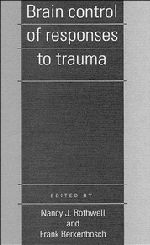Book contents
- Frontmatter
- Contents
- Contributors
- 1 Introduction
- 2 Responses to injury
- 3 Experimental approaches to the central nervous system control of responses to trauma
- 4 Neurohormonal control of cytokines during injury
- 5 Brain regions involved in modulation of immune responses
- 6 Psychological and neurobiological consequences of trauma
- 7 Central nervous system control of sickness behavior
- 8 Psychological and behavioural aspects of pain
- 9 Central control of cardiovascular responses to injury
- 10 Neuroendocrine responses to physical trauma
- 11 Central control of metabolic and thermoregulatory responses to injury
- 12 Central control of pain
- 13 The final word …
- Index
7 - Central nervous system control of sickness behavior
Published online by Cambridge University Press: 05 August 2016
- Frontmatter
- Contents
- Contributors
- 1 Introduction
- 2 Responses to injury
- 3 Experimental approaches to the central nervous system control of responses to trauma
- 4 Neurohormonal control of cytokines during injury
- 5 Brain regions involved in modulation of immune responses
- 6 Psychological and neurobiological consequences of trauma
- 7 Central nervous system control of sickness behavior
- 8 Psychological and behavioural aspects of pain
- 9 Central control of cardiovascular responses to injury
- 10 Neuroendocrine responses to physical trauma
- 11 Central control of metabolic and thermoregulatory responses to injury
- 12 Central control of pain
- 13 The final word …
- Index
Summary
I feel sick. What is usually meant by this deceptively simple statement? The non-specific symptoms of infectious diseases include profound behavioral and psychological changes. Sick individuals are febrile, hypersomnia depressed and lethargic. In addition, they experience malaise, generalized aches and pains, an inability to concentrate, loss of appetite, and a lack of interest in usual activities, including social contacts and sex. This constellation of non-specific symptoms is collectively referred to as 'sickness behavior’ (Hart, 1988; Kent et al., 1992a). Regardless of, or perhaps more precisely, because of their commonality, they are frequently ignored by physicians because they contribute little in facilitating a diagnosis. In fact, they are more often considered as an uncomfortable, but generally banal, part of the pathogen-induced debilitative process. Their commonality and their evolutionary conservation, however, suggest other reasons for their presence.
Fever, for example, is not merely a symptom but is an adaptive response that enables a host to defend itself against, and survive, infection by a pathogen. It is an evolutionary response that has now been demonstrated in fish, reptiles, and even invertebrates, such as mollusks and insects (for a review, see Kluger, 1991). The medical dogma of the twentieth century has suggested that fever should be prevented; however, strong evidence now suggests otherwise. Preventing the manifestation of fever in poikilothermic animals by placing them in a cool environment, or in homeostatic animals by the administration of prostaglandin (PG) synthesis inhibitors, is detrimental to their survival (for a review, see Kluger, 1991). Although, for the most part, experimental evidence is lacking, arguments can also be made for the contribution of sickness behavior to the survival of infected organisms (Hart, 1988). Recent evidence is that these non-specific symptoms are induced and controlled by the proinflammatory cytokines released by an activated immune system, and that they play a role in the recuperative process. This review focuses on the role of the central nervous system in regulating sickness behavior.
Communication between the immune and central nervous systems The cells of the immune system release a plethora of soluble factors in response to infection, tissue injury, neoplastic growth, or immunological disorders. The principal proinflammatory compounds are the cytokines, interleukin (IL)-l, IL-6, tumor necrosis factor alpha (TNF-a), and the interferons (IFN).
- Type
- Chapter
- Information
- Brain Control of Responses to Trauma , pp. 152 - 182Publisher: Cambridge University PressPrint publication year: 1994



